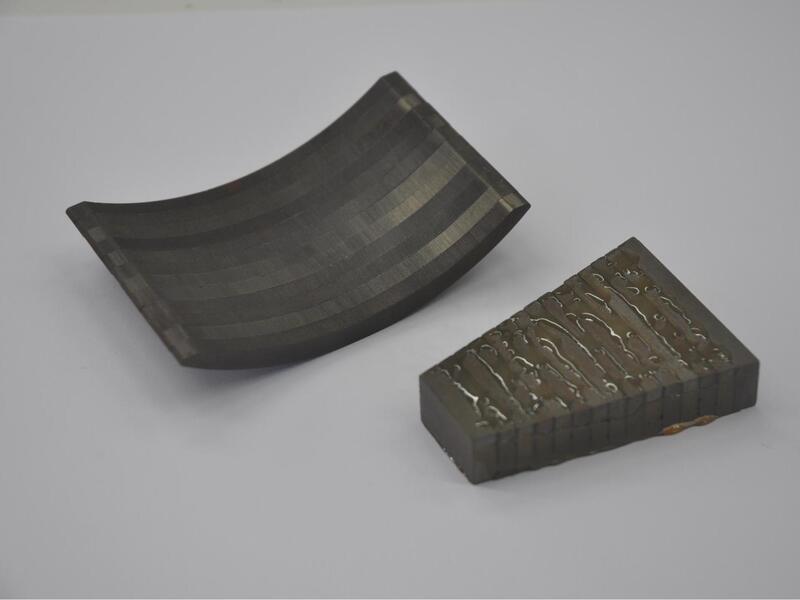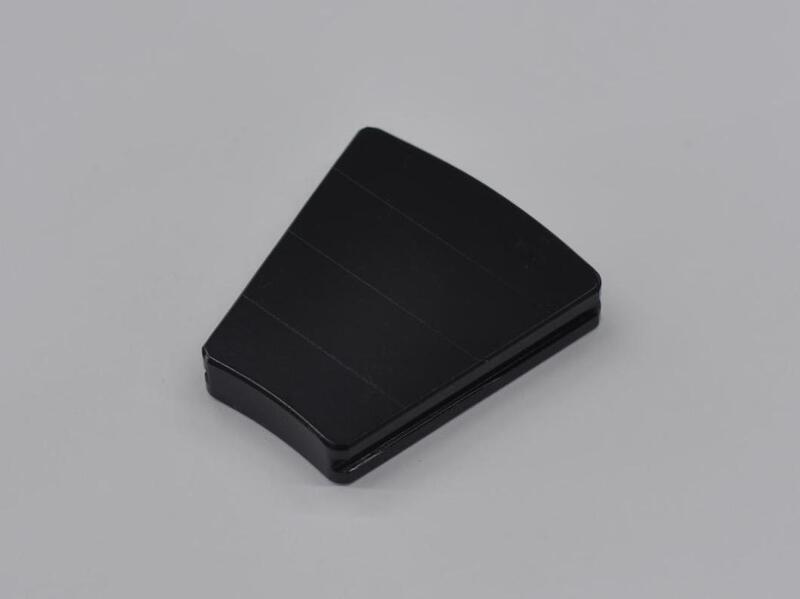
多片粘接磁体是将整个磁铁切成许多小磁铁,然后用特定的胶水将它们粘合在一起。这些小磁铁彼此绝缘,可以降低磁涡流。
当永磁电机运行时,电机会产生谐波,磁铁会产生集肤效应,这些都会带来大量的涡流损失(Heat loss)。然后,永磁体的温度升高,导致不可逆的退磁,影响电机运行的安全性和稳定性。因此,多片粘接磁体的设计(多重堆叠方法,每个磁体之间需要绝缘)可以减少这种热损失并降低风险。
钕铁硼永磁体的涡流模拟实验:





1.磁体的涡流损耗随着磁体段的增加而减小。
2.磁体的涡流损耗随励磁频率的增加而增大
1. 绝缘层(胶层)的厚度在 0.04mm.
2. 在常温下,绝缘层的粘结强度可达 50Mpa.
3. 最高工作温度可达200°C.
4. 整个几何公差可以在 0.05mm.
5. 这些小磁铁彼此绝缘。
1. 减少电磁涡流
2. 保持与整个磁铁相同的磁性能甚至优越。
电动汽车汽车、航空航天、赛车运动、高速永磁电机和智能工业机器人市场正在转向层压稀土磁铁,并正在努力平衡功率和热量之间的权衡。
多片粘接磁体可以减少高效电机的涡流损耗,涡流损耗越小,发热量越低,效率越高。

|
技术特点: |
|
绝缘刚度≥1 MQ 剪切强度≥1MPa 胶粘接间隙0.05-0.2mm 叠层厚度≥1mm |
|
应用: |
|
EV牵引电机 轨道交通牵引电机 大功率力矩电机 等 |


钕磁铁在各个领域都有广泛的应用和用途。
在电子领域,钕磁铁常用于扬声器、耳机和麦克风。钕磁铁的强磁场有助于提高这些音频设备的音质和性能。
在汽车行业,钕磁铁用于电动汽车电机和混合动力汽车系统。它们有助于这些车辆的高效运行和高功率输出,提高其性能和能源效率。
钕磁铁在硬盘驱动器 (HDD) 和其他数据存储设备的制造中也是必不可少的。它们有助于读/写头的精确移动和控制,从而实现数据的存储和检索。
在可再生能源领域,它们用于风力涡轮机发电。钕磁铁的强磁性有助于将机械能有效地转化为电能。
此外,钕磁铁还用于各种消费品,如玩具、磁性珠宝和冰箱磁铁。它们还用于工业机械和设备中,用于固定、提升和分离磁性材料。
总之,钕磁铁在我们日常生活和工业的许多方面都发挥着至关重要的作用,为技术进步和在各种应用中的性能改进做出了贡献。
磁铁概述:
烧结钕铁硼被称为“磁王”,是第三代稀土永磁材料,也是世界上最强的永磁材料,具有优异的磁性能。广泛应用于汽车工业、工业电机、消费电子、清洁能源、航空航天等领域;磁体的主要成分是 Nd2Fe14B,它具有极高的磁性能。其 BH max 比铁氧体高 10 倍以上,最高工作温度可达 250 °C。它的机械性能也相当好。适用于磨削、线切割和钻孔等不同的加工方法;由于其耐腐蚀性差,表面必须根据不同的要求进行不同的涂层加工(如涂有Zn、Ni、Au、Epoxy等)。
主要特点:
NdFeB磁体是通过粉末冶金法制备的,其化学成分为Nd2Fe14B,具有优良的磁性能。其优点:退磁电阻高,性价比高,但其缺点:温度依赖性相对较强,耐腐蚀性相对较弱,但经过合适的牌号与高性价比的磁路设计加上在不同使用环境中不同程度矫顽力的正确涂层或电镀后,钕铁硼可以满足不同的应用要求。
工艺流程:
合金熔炼 氢分解 射流铣削 压制 烧结退火 BH曲线试验 机械加工 晶界扩散涂层检查 充磁化填料
磁性能:
N系列:N35-N55,M系列:35M-54M,H系列:35H-54H,SH系列:33SH-54SH,UH系列:28UH-52UH,EH系列:28EH-50EH,AH系列:28AH-48AH
应用:
应用:电动汽车/汽车行业、风力涡轮机、家用电器、工业自动化、电子产品和医疗设备。


定制的 NdFeB 磁体具有以下具体优势,使其成为各种应用行业的热门选择。优点如下:
1.高磁强度:NdFeB 磁体在所有已知的永磁体中具有最高的磁强度(磁密度),被称为“磁王”.
2.紧凑的尺寸:NdFeB 磁体具有最高的能量密度,这意味着它们在需要最小化尺寸或重量的应用中具有“小型化”或“轻量化”的特殊优势, 如在3C领域
3.宽范围温度稳定性:钕铁硼磁体具有优异的温度稳定性,居里温度高(完全退磁温度,310-380°C),可在较宽的工作温度范围内可靠运行(工作温度范围:-40°C-250°C)。
4. 多功能性:钕铁硼磁铁可根据具体应用进行定制。它们可以制造成各种形状、尺寸和等级,以满足特定的磁性要求。
5.成本效益:钕铁硼磁铁具有很高的磁场强度成本比,使其成为许多应用的经济高效选择。
6.防退磁:NdFeB 磁铁具有高抗退磁性,这意味着即使在具有挑战性的操作条件下,它们也会随着时间的推移保持磁性。这使得它们适用于需要稳定磁性的长期应用。
7.广泛的应用范围:NdFeB 磁体应用广泛,包括电动机、发电机、磁选机、磁共振成像 (MRI) 机、扬声器、磁电梯、风力涡轮机等。
总体而言,定制 NdFeB 磁体的优点是磁强度高、尺寸紧凑、温度稳定性好、多功能性、成本效益高、防退磁和应用范围广。这些特性使它们成为各行各业有价值且越来越受欢迎的磁铁材料。






